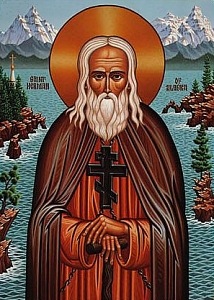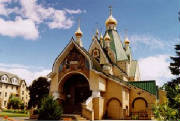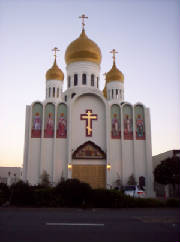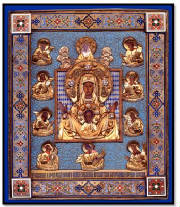What is the Russian
Orthodox Church Outside Russia?
In 1740, explorer Vitus Bering, with two ships, left
the port city of Petropavlosk-Kamchatskiy in Russia and sailed to the east. The two ships, the St. Peter and the
St. Paul, were separated during the voyage, but Bering sighted the southern coast of Alaska, and landed on Kayak
Island; while  Aleksei Chirikov, captain of the St. Paul, landed on the Aleksander Archipelago off the southeast
coast of Alaska.
Aleksei Chirikov, captain of the St. Paul, landed on the Aleksander Archipelago off the southeast
coast of Alaska.
As the numbers of fur-bearing animals in Siberia declined due to intense
hunting, trappers followed Bering's route to reach the Aleutian Islands and Alaska, eventually making
their way down the Pacific Coast to Fort Ross, just north of San Francisco. The rich fur resources there led to the colonization
of the region; and the Church responded to the spiritual needs of the colonists by sending eight monks (one of whom, St.
Herman, is the saint for whom our sister parish in Tucson is named) from the monastery at Valaam to the new land. They arrived on Kodiak Island on September 24, 1794. Thus it was
that the Orthodox Church and faith came to North America from Russia.
Many people do not know that the "Russian
Revolution" of 1917 was actually two separate revolutions. In the first, which took place in February (according to
the Russian calendar) the last Tsar, Nikolai II (now recognized as the Tsar-Martyr, along with his wife, the heir to the throne, Aleksiy, and
the Tsar's daughters, the Grand Duchesses Olga, Tatiana, Maria, and Anastasia, who all are also among the Royal Martyrs), was deposed, and a "Provisional Government" assumed authority in the
Russian Empire. The Provisional Government, which was meant as a temporary step until free elections could be held and a
"Constituent Assembly" convened to adopt a constitution for the Empire, experienced many changes, and was never
effectively in control of the events and circumstances in which it found itself. One consequence was the "October Revolution,"
which brought Lenin and the Bolsheviks to power in the Russian land. A civil war followed; and, when it was done, the Bolsheviks
had won, and the Soviet Union came into being.

The Patriarchate in Russia had been abolished by Peter the Great, and it was not until after the February
Revolution that the Church was free to elect a Patriarch. Metropolitan Tikhon (now recognized as a saint among the New Martyrs and
Confessors of Russia), who had served for a time in the United States, was elected to lead the Church as her Patriarch during
the tumultuous times in Russia. In the midst of the Civil War, recognizing that many of the faithful, with their clergy
and bishops, were unable to be in communication with the office of the Patriarch, St. Tikhon issued an order allowing the
hierarchs in these outlying regions to organize themselves into temporary "Higher Church Authorities" that would
function in a conciliar way to guide the churches in their care until it was once more possible for full communication to
be restored. The death of St. Tikhon, and the inability of the Church, blocked by the God-opposing Bolshevik state authorities,
to meet to elect a new Patriarch, led to the formation of the Russian Orthodox Church Outside Russia, in conformity with
the order that St. Tikhon had issued.
As such, the Russian Orthodox Church Outside Russia
(known variously as ROCOR, ROCA, and "the Synod") came into being to care for the faithful who found themselves
outside of their Russian  homeland; and for the converts who would come to share the Orthodox faith and way of life with the exiles
and emigres in their midst. The Russian Church Abroad always considered herself to be part of the divided Russian Orthodox
Church, and an inheritor and conservator of the teachings and practices of the Russian Orthodox Church.
The subjugation of the administrative offices of the Church in Russia to the Bolshevik authorities (who later called themselves,
"Communists") prevented the re-establishment of relations between the Churches of ROCOR and in the Russian homeland;
but ROCOR never ceased to hope and pray that the Russian land would one day be set free from the Communist
yoke, and that the wounds of the civil war and Communist rule could be healed. The resurgence of Orthodoxy in Russia following
the collapse of the Soviet Union in 1991, and the actions taken by the Church of the Moscow Patriarchate (which was re-established
by Stalin in 1943 as he sought ways to rally the Russian people to fight against the invaders from Nazi Germany in World
War II) at their assembly in the summer of 2000, opened the door to a dialogue between the Church in Russia and ROCOR.
homeland; and for the converts who would come to share the Orthodox faith and way of life with the exiles
and emigres in their midst. The Russian Church Abroad always considered herself to be part of the divided Russian Orthodox
Church, and an inheritor and conservator of the teachings and practices of the Russian Orthodox Church.
The subjugation of the administrative offices of the Church in Russia to the Bolshevik authorities (who later called themselves,
"Communists") prevented the re-establishment of relations between the Churches of ROCOR and in the Russian homeland;
but ROCOR never ceased to hope and pray that the Russian land would one day be set free from the Communist
yoke, and that the wounds of the civil war and Communist rule could be healed. The resurgence of Orthodoxy in Russia following
the collapse of the Soviet Union in 1991, and the actions taken by the Church of the Moscow Patriarchate (which was re-established
by Stalin in 1943 as he sought ways to rally the Russian people to fight against the invaders from Nazi Germany in World
War II) at their assembly in the summer of 2000, opened the door to a dialogue between the Church in Russia and ROCOR.
The dialogue bore good fruit. In May of 2007, on the Feast of the Ascension of our Lord Jesus Christ, the "Act of Communion" was signed in the Cathedral of  Christ the Savior in Moscow by Patriarch ALEXEI II and Metropolitan LAURUS. With this, these two parts of the one Russian Church have been restored to oneness of communion.
Christ the Savior in Moscow by Patriarch ALEXEI II and Metropolitan LAURUS. With this, these two parts of the one Russian Church have been restored to oneness of communion.

 Aleksei Chirikov, captain of the St. Paul, landed on the Aleksander Archipelago off the southeast
coast of Alaska.
Aleksei Chirikov, captain of the St. Paul, landed on the Aleksander Archipelago off the southeast
coast of Alaska.
 homeland; and for the converts who would come to share the Orthodox faith and way of life with the exiles
and emigres in their midst. The Russian Church Abroad always considered herself to be part of the divided Russian Orthodox
Church, and an inheritor and conservator of the teachings and practices of the Russian Orthodox Church.
The subjugation of the administrative offices of the Church in Russia to the Bolshevik authorities (who later called themselves,
"Communists") prevented the re-establishment of relations between the Churches of ROCOR and in the Russian homeland;
but ROCOR never ceased to hope and pray that the Russian land would one day be set free from the Communist
yoke, and that the wounds of the civil war and Communist rule could be healed. The resurgence of Orthodoxy in Russia following
the collapse of the Soviet Union in 1991, and the actions taken by the Church of the Moscow Patriarchate (which was re-established
by Stalin in 1943 as he sought ways to rally the Russian people to fight against the invaders from Nazi Germany in World
War II) at their assembly in the summer of 2000, opened the door to a dialogue between the Church in Russia and ROCOR.
homeland; and for the converts who would come to share the Orthodox faith and way of life with the exiles
and emigres in their midst. The Russian Church Abroad always considered herself to be part of the divided Russian Orthodox
Church, and an inheritor and conservator of the teachings and practices of the Russian Orthodox Church.
The subjugation of the administrative offices of the Church in Russia to the Bolshevik authorities (who later called themselves,
"Communists") prevented the re-establishment of relations between the Churches of ROCOR and in the Russian homeland;
but ROCOR never ceased to hope and pray that the Russian land would one day be set free from the Communist
yoke, and that the wounds of the civil war and Communist rule could be healed. The resurgence of Orthodoxy in Russia following
the collapse of the Soviet Union in 1991, and the actions taken by the Church of the Moscow Patriarchate (which was re-established
by Stalin in 1943 as he sought ways to rally the Russian people to fight against the invaders from Nazi Germany in World
War II) at their assembly in the summer of 2000, opened the door to a dialogue between the Church in Russia and ROCOR. Christ the Savior in Moscow by Patriarch ALEXEI II and Metropolitan LAURUS. With this, these two parts of the one Russian Church have been restored to oneness of communion.
Christ the Savior in Moscow by Patriarch ALEXEI II and Metropolitan LAURUS. With this, these two parts of the one Russian Church have been restored to oneness of communion.